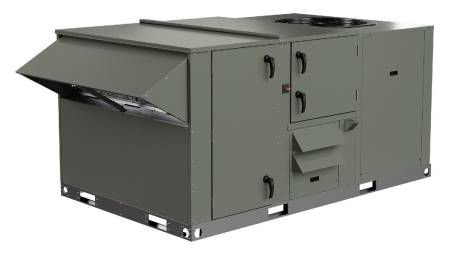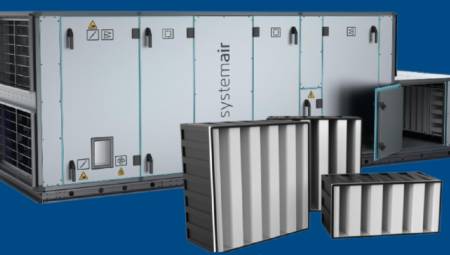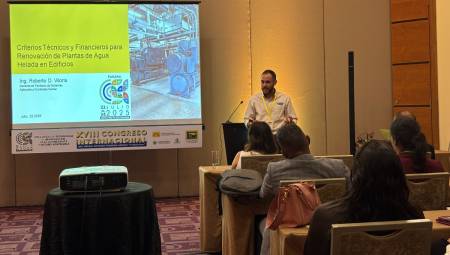The following text will discuss the correct way to diagnose and troubleshoot a thermal expansion valve (TXV) system for flow control.
By: Al Maier*
 With the emergence of the minimum 13 SEER standard in January 2007, virtually all residential split air conditioning manufacturers stopped designing equipment with flow meters and instead used thermal expansion valves (TXV, to regulate the rate of refrigerant feeding the evaporator. TXV valves make it possible for the system to use energy more efficiently by keeping the evaporator closer to the optimal superheat level in all operating conditions. In addition, it allows the system a rapid decrease in suction pressure under optimal conditions after a shutdown cycle.
Operation and operation of TXV valves
Although TXV valves offer many operational advantages, those unfamiliar with them consider them a mysterious device and end up replacing them unnecessarily. The TXV valve has a single function: to control the flow of coolant passing to the evaporator in an exact proportion to the evaporation rate of the refrigerant in the evaporator. By responding to the temperature of the refrigerant gas leaving the evaporator and the pressure of the evaporator, the TXV valve can control the gas leaving the evaporator at a predetermined superheater.
Superheat is the temperature of a vapor that is above its saturation temperature. It is calculated by measuring the actual temperature of the evaporator outlet and subtracting the temperature corresponding to the evaporation pressure.
To locate faults in a TXV valve it is important to first understand how it works. There are three forces that determine the operation of a TXV valve. P1, i.e. the pressure created by the remote bulb; P2, the pressure of the evaporator or equalizer, and P3, the equivalent pressure of the superheat spring.
The pressure of the remote bulb (P1) corresponds to the cooling temperature coming out of the evaporator.
When this pressure increases, the valve needle tends to the "open" position. Opposed to this force, influencing the lower part of the diaphragm and moving the needle in a "close" direction, is the force exerted by the pressure of the evaporator and that exerted by the superheater spring. The valve will assume a stable position when these forces are in equilibrium (P1=P2+P3).
When the temperature of the refrigerant leaving the evaporator rises above its saturation temperature—corresponding to the pressure of the evaporator—the pressure in the remote bulb increases, causing the valve needle to move in the "open" direction. Conversely, when the temperature of the refrigerant gas leaving the evaporator decreases, the pressure in the remote bulb becomes lower and the valve needle moves in the "close" direction.
The factory adjustment of the TXV valve superheater is done with the needle starting to lift from the seat.
An increase in the superheater is necessary for the valve to open to its sorting position. This is an important concept, as it means that a valve with a factory setting of 8° will not maintain an 8° superheater at a maximum load. An additional superheater is necessary to make the valve "rub" its sorting ability.
With the emergence of the minimum 13 SEER standard in January 2007, virtually all residential split air conditioning manufacturers stopped designing equipment with flow meters and instead used thermal expansion valves (TXV, to regulate the rate of refrigerant feeding the evaporator. TXV valves make it possible for the system to use energy more efficiently by keeping the evaporator closer to the optimal superheat level in all operating conditions. In addition, it allows the system a rapid decrease in suction pressure under optimal conditions after a shutdown cycle.
Operation and operation of TXV valves
Although TXV valves offer many operational advantages, those unfamiliar with them consider them a mysterious device and end up replacing them unnecessarily. The TXV valve has a single function: to control the flow of coolant passing to the evaporator in an exact proportion to the evaporation rate of the refrigerant in the evaporator. By responding to the temperature of the refrigerant gas leaving the evaporator and the pressure of the evaporator, the TXV valve can control the gas leaving the evaporator at a predetermined superheater.
Superheat is the temperature of a vapor that is above its saturation temperature. It is calculated by measuring the actual temperature of the evaporator outlet and subtracting the temperature corresponding to the evaporation pressure.
To locate faults in a TXV valve it is important to first understand how it works. There are three forces that determine the operation of a TXV valve. P1, i.e. the pressure created by the remote bulb; P2, the pressure of the evaporator or equalizer, and P3, the equivalent pressure of the superheat spring.
The pressure of the remote bulb (P1) corresponds to the cooling temperature coming out of the evaporator.
When this pressure increases, the valve needle tends to the "open" position. Opposed to this force, influencing the lower part of the diaphragm and moving the needle in a "close" direction, is the force exerted by the pressure of the evaporator and that exerted by the superheater spring. The valve will assume a stable position when these forces are in equilibrium (P1=P2+P3).
When the temperature of the refrigerant leaving the evaporator rises above its saturation temperature—corresponding to the pressure of the evaporator—the pressure in the remote bulb increases, causing the valve needle to move in the "open" direction. Conversely, when the temperature of the refrigerant gas leaving the evaporator decreases, the pressure in the remote bulb becomes lower and the valve needle moves in the "close" direction.
The factory adjustment of the TXV valve superheater is done with the needle starting to lift from the seat.
An increase in the superheater is necessary for the valve to open to its sorting position. This is an important concept, as it means that a valve with a factory setting of 8° will not maintain an 8° superheater at a maximum load. An additional superheater is necessary to make the valve "rub" its sorting ability.
Detection and solution of faults in TXV valves
There are three main failure modes in a TXV valve. The valve may be feeding too much coolant (supercharging); may not be feeding enough refrigerant (underfeeding); or it may alternate from feeding too much to too little (fluctuation). Below we will discuss each of these flaws in detail:
Overfeeding
It occurs when the amount of refrigerant feeding to the evaporator is greater than what can be evaporated, causing the coolant to be returned to the compressor. Overcharging symptoms include frosting of the compressor cover, noise emission in the compressor, low superheat in the evaporator, and normal or above normal suction pressures.
Flooding may be due to any of the following causes:
• Inefficient or smaller than normal compressor: if the compressor capacity is low, the suction pressure will be higher than normal and the superheater will be low. If you suspect this is the problem check with the compressor manufacturer.
• Low superheat adjustment: In external adjustment valves, turn the stem clockwise to increase the superheat.
• Moisture: Any water residue in the system can freeze on the TXV valve, preventing it from working properly. If you think this is the case, install a good filter dryer for the liquid line. It is also advisable to install a humidity indicator for the liquid line that allows the technician to monitor the humidity level of the operating system.
• Dirt or debris: any foreign material that manages to pass the inlet filter can get lodged between the needle and the port of the TXV valve, preventing it from closing properly. Again, the recommendation is to install a filter dryer in the system to prevent the circulation of dirt and debris that can cause failures in the operation of the system.
• TXV valve seat drip: If the needle and port are not properly seated, liquid coolant will flow through the valve, which should not happen. When checking the valve, impurities and debris may appear. If so, the TXV valve can be cleaned and put back into operation. If inspecting the valve shows damage to the needle or port caused by wire drawing or erosion of the needle, the valve should be replaced.
• Larger than normal valve: Make sure that the valve specified by the equipment manufacturer has been installed in the system. A valve too large for the capacity of the system will tend to overfeed.
• Incorrect position of the bulb: ideally, the bulb of the power element is located in a horizontal section of the suction line - immediately after the evaporator outlet. It should be very close to the equalizer connection, but upstream. The bulb must be firmly attached to the suction line to maintain good thermal contact. In addition, the bulb should not receive external sources of heat.
______________________________________________________________________
Box To calculate the superheat:
- Determine the suction pressure at the evaporator outlet.
- Use a pressure/temperature table for the appropriate refrigerant and determine the saturation temperature corresponding to the pressure measured in step 1.
- Measure the temperature of the suction line at the location where the remote bulb is located.
- Subtract the saturation temperature you set in step 2 to the measured temperature in step 3. The resulting difference is the superheater.
Superheater adjustment for external adjustment TXV valves only:
- Remove the seat cover from the bottom of the valve, leaving the adjustment stem exposed.
- Turn the stem clockwise to increase the superheater – decrease the flow of the coolant.
- Turn the stem counterclockwise to decrease the superheater – the flow of the coolant increases.
*Al Maier is vice president of application engineering at Emerson Climate Technologies Flow Control Division. For more information, call: 314-569-4680 or email: [email protected].













